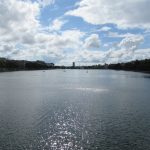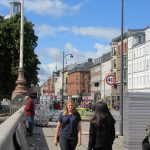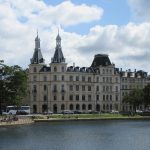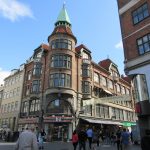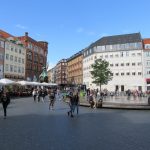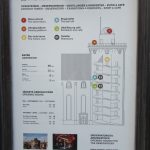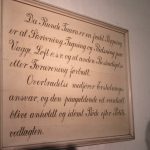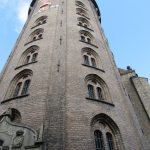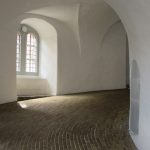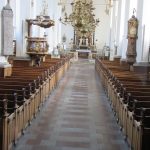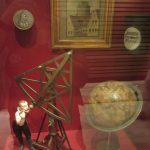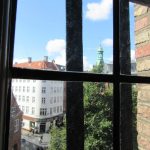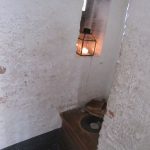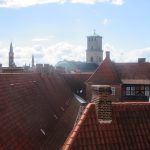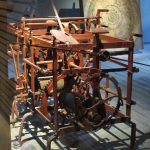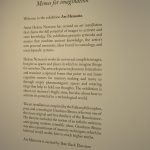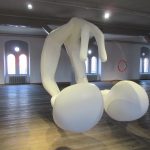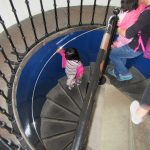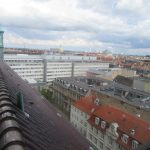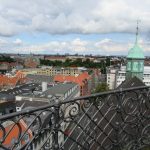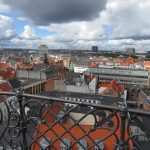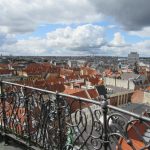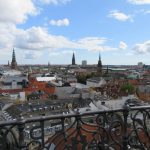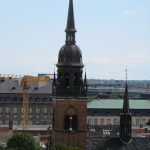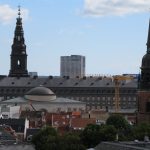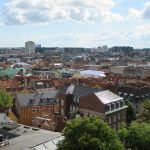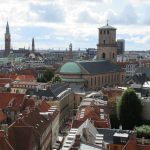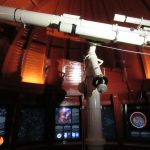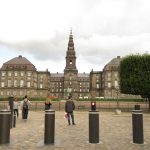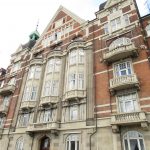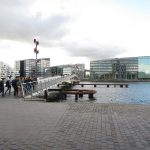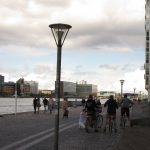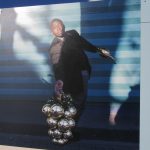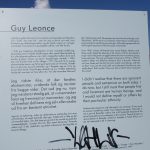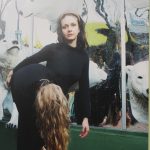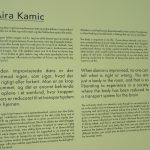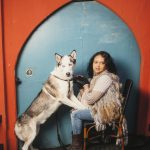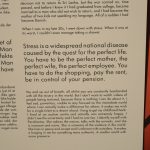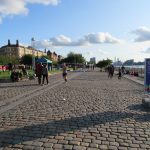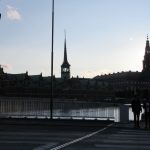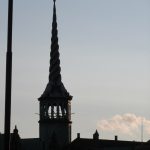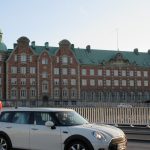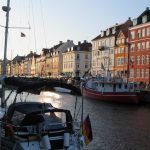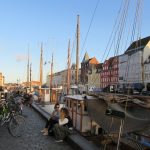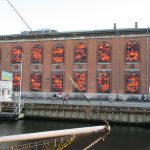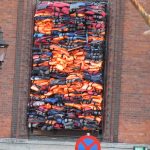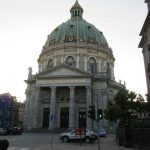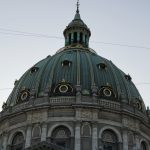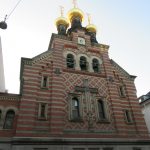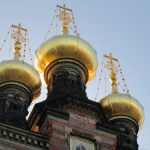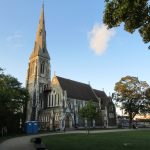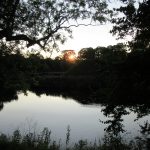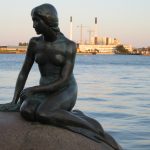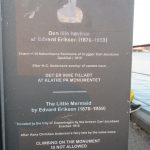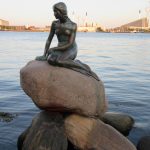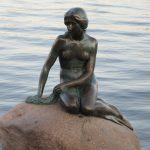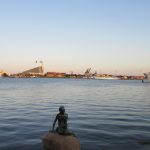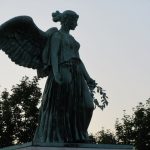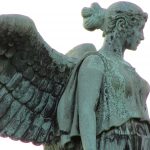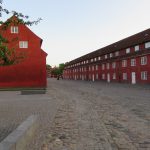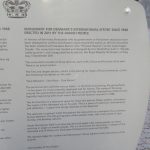8/27/17
I did not get up early after all.
Maybe it’s the time difference from Iceland, but I woke up around 11:30am. I wanted to go to the Balkan dance party at the Kulturhaven Festival, but I just didn’t see myself getting out of the house in time. My friend Anna had told me about an American Tribal Style belly dance performance at the festival that afternoon, so I decided to aim to attend that instead. I took my time waking up and cooking muesli for breakfast. I would try and do some sight-seeing before the performance at 4 o’clock so I got on the bike and headed towards the Rundetårn or “Round Tower.” Malle had messaged me some places to check out including the Rundetårn, the castle Rosenborg Slot, and The Little Mermaid statue. The Rundetårn is in the middle of a big shopping area. I had to get off my bike and walk for fear of hitting someone. As I walked my bike, I drank in the modern, shiny shops inside the antiquated brick and stone buildings. A man sat on the footsteps of a bank playing a minor key on the accordion and my heart sang with the music. I passed by a Danish raver store where the mannequins donned rainbow feathered wings, unicorn horns, and brightly colored wigs. I sent a picture to one of my best friend’s back home since it reminded me of our party kid days.
- Peplinge Sø?
- Biking down Nørrebrogade
- What is this castle?
- Beautiful architecture
- Shopping area-Kultorvet?
I finally came to a tall brick cylinder rising from the stone streets. The little glass booth where you paid your 25 krone entry seemed out of place against the white plaster and wood-paneled floors from a textbook of Danish history. As I walked up the spiraling wooden plane, I’d look out of the small ironwork windows to see the Copenhagen skyscape drifting further and further below me. Every few floors a new exhibit would emerge such as the old bell tower section or the privy.
- Info sign
- Info sign?
- Looking up at the Rundetårn
- Walking the spiral, wooden ramp up the tower
- Peeking inside one of the alcoves
- Old school astronomical equipment
- Incredible view walking up the tower and looking out windows
- The privy
- Looking out over rooftops
- Old school astronomical equipment
The one that really caught my attention was an art exhibit called “Ars Memorie” by the artist Helene Nymann. I walked into a white room where a sculpture floated in the air suspended from a guide wire in the ceiling. The piece could have been a dancer bending backwards, a face-hugger from “Alien,” or the anatomically accurate tubing of testicles. Several metal rings hung independently in the surrounding space also slowly turning, almost imperceptibly. The whole exhibit centered on how our memory works and how we fill in the space of perception with meaning. I walked to the back of the room behind a gray velvet curtain where I watched a movie of a woman narrating over the camera moving around a house. White morphing shapes like spiral-graphs fused into 3-D models of various thoughts. The part that moved me the most about the piece was the woman narrating the story telling the audience that this is where she lets her imagination take hold, where thoughts form the amalgamation of who she is. The house turned out to be the place she grew up in. The bird she had as a child flew into the picture almost translucent like a ghost of who she remembered it to be. I felt absorbed into her world.
- Information about the piece “Ars Memorie” by Helene Nymann
- Our imagination creates images of what we perceive things to be based on our memory
The blurb at the entrance of the entire exhibit read that the sculpture/mobile piece resembled things that we know of, but allowed for the space of our memories to fill in the meaning behind the objects. The artist felt inspired by cosmology and theories of the infinity of the universe. Appropriate for a tall tower used as an observatory.
I continued my climb up the tower and when I emerged from the zenith, I held back a gasp at the city scape below. I thought of my high school trip to Spain when we climbed to the top of a tower in Toledo. When I had looked down it really hit home that I was in a different place. All the buildings had been made of old brick and stone, testaments of history older than anything western-related in America. I felt that same nostalgia looking down at the brown brick, green oxidized copper, white plaster, and black iron of the skyscape of Copenhagen. The tops of the castles jutting their heads out of the jagged rooftops looked like crown jewels adorning an aged necklace. Off in the distance turned the windmills building up sustainable energy, and somewhere even further out lay Sweden. I have seen so many vistas on this trip that I have attempted to put into words the best that I can, but sometimes with art, as Helene Nymann says, we can only create the space in which the imagination of the audience can fill in the gaps. I should mention that to get to this viewpoint, one has to ascend the narrowest spiral staircase bumping against other uncomfortable tourists trying to descend. If you climbed another very narrow staircase half a flight further up, you witnessed the observatory. Now inaccessible to tourists, it displayed a white telescope and back-lit displays of constellations illuminating the bodies of ancient Greek gods seen in the stars.
- Climbing up the spiral staircase to the top
- View from the top
- Walking
- Around
- The
- Deck
- Close up of castle
- More castles?
- The city below
- Zooming in
- Inside the observatory
By the time I descended back down the length of the tower, I decided that since it took me so long to get places due to my unfamiliarity of the area and the unreliability of Google Maps, I would head to Island Brygge to the Kulturhaven Festival sooner rather than later. I stopped to snap photos of castles as I cycled across the cobblestone roads to the path alongside the canal. The road led across the water where a mall sat in its glass enormity in the middle of the bridge. It’s like they made it intentionally hard to get around so you had to go through it. After confusing a picture of a blue bicycle painted on the wall over a tunnel as the path to the throughway (it actually lead to a bike shop), I circumnavigated the mall the path to continue the path to the island.
- More castles?
- Just a random gorgeous building face
- View from crossing bike path to Island Brygge
- Looking out over water from Island Brygge
The water in the canal glistened like a blue gem. Bicyclists crisscrossed the paths while families sat on docks along the water. In the distance, I heard the sound of a doumbek. I must be close! I cycled north along the water and soon a keyboard, guitar, saxophone, and more instruments joined the doumbek in a joyous baladi. I could barely contain myself as I saw a woman covered in a mirrored dress appear on a small covered stage. This must be it! I grabbed a Carlsberg IPA (I definitely have broken my beer fast on this trip) and found myself a spot to stay a while. I zaghareet’d in delight watching the various cabaret belly dancers including a man in a long white Turkish robe.

Belly dancers!
Songs passed by and the 4 o’clock hour when the performance was to begin drew near, but I did not see anyone in the recognizable ATS costumes. I was beginning to think that I had missed it. I stayed through most of the show until I was convinced they were not going to appear. I finally saw a woman in the telltale hair garden and flowing skirts sit down next to me and I approached her asking where the ATS performance was. She was surprised that I knew what that was, and she told me it already happened at the other stage. There is another stage? I asked her if there were any classes I could take while I was in Copenhagen. She told me about a tribal fusion class with a teacher named Dud Muurmand. I recognized that name because Anna had recommended her as well. After our conversation ended, I found myself wandering away to look at the public art around me.
The festival displayed an art exhibit where a photographer Maja Nydal Eriksen (http://www.100pctfremmed.dk/) had taken pictures of different refugees chosen to present their answer to the question, “Do you feel 100% foreign?” They went to Tivoli Gardens and posed with props, their family, whatever they wanted so that their portrait stood alongside their story.
As a writer collecting stories across the world, I felt captivated by what these people had to say. Some felt lost, some at home, some longing to return, some rejecting Denmark, their home, or both. I tried to see if there was a book collecting these stories, but I only got a flier from a man who seemed too busy to talk to me.
The story of Hassan Nur Wadere from Somalia said that he believed everyone is born good: “What may change a human being is their upbringing and the structure of the society. So you must return the things to the society that can bring back the good in people again” (Eriksen, Maja Nydal. 100% Freemed. Photograph. Island Brygge, Copenhagen. http://www.100pctfremmed.dk/)
Galawiesh Abeid said you can feel foreign even if you are fully acculturated in a society:
There is more to life than being pretty and sweet, and life is in fact more than me, my husband, and my happiness. You must try to make a difference for others than yourself and your family. I love when someone says: “My child, you are not the center of the world: the more energy you feed your ego, the more it needs. I came to Denmark because I needed security for myself and my family. But having got used to this security, I became aware of something in society which shocked me. People concentrate a lot on their ego. [I]t doesn’t make sense to me to say that you make your own happiness, as the Danish saying goes. My happiness depends to a large extent on other people, and in my family there is no such thing as your problem. It is always ours. (Ibid)
I wanted to reach through the picture of the woman holding her young son with her daughter standing at her side in motorcycle gear. I hear you.
The story of a man from Rwanda named Guy Leonce said that the neighborhood I was staying in, Nørrebro, was called “the black hole” by the newspapers, but for him, “It is a nice place, where Danes and foreigners meet, and where something new emerges. A flawed language adorned with English expressions that everyone understands” (Ibid).
- All rights reserved to Maja Nydal Eriksen http://www.100pctfremmed.dk
- All rights reserved to Maja Nydal Eriksen http://www.100pctfremmed.dk
I will quote the rest of his story because, to be honest, the media in the USA doesn’t focus on global politics as much as the Ameri-centric news that these days doesn’t really seem to be news at all, but mindless chatter. The news in America is akin to what in theater they call “walla”: the wash of unintelligible noise that a crowd creates and sounds like nonsense. I admit what I know of the Armenian and Rwanda genocides is what I have learned from history textbooks and schoolrooms. As with all things, history comes to life in the voices of the living, breathing people. Leonce said:
From 1938, citizens of Rwanda were issued Belgian identity cards. These cards stated the ethnicity of all citizens and this has played a major role in the power struggle between the two main ethnic groups, Hutsuts and Tutsis. The civil war began in Rwanda in 1994. In 1972 my mother’s father was killed by extremist Tutsis in Burundi. When the Civil War broke out she lost her Tutsi mother and siblings, and then we fled. I was just ten and could not understand what the war was really about. Did it matter if one was Tutsi or Hutu? Wasn’t everyone the same?
I didn’t realize that there are ignorant people and extremists on both sides. I do now, but I still insist that people first and foremost are human beings, and I would not define myself or others by their particular ethnicity.
I believe that education and information are necessary if one wants to prevent something similar from happening again. Genocide is not a part of Rwandan culture, but it all happened because of the social and political circumstances in the country. There has been no reconciliation in Rwanda, unlike for example in South Africa, so I am, not interested at all in returning. (Ibid)
It is terrifying how familiar this all sounds to modern states of affairs.
A dancer named Aira Kamic wrote in her story her relationship to her body as a dancer. How she chose not to seek a profession as a dancer so she would not have her body reduced to a tool and the things it could do. “When dance is improvised,” she says, “No-one can tell what is right or wrong. You are just a body in the room, and that is so liberating to experience in a society where the body has been reduced to a transport system for the brain” (Ibid). Isn’t it strange how you encounter art, books, literature, and moments in the world around you that sync up with the things you feel in your own life? It is enough to make one believe in fate.
- All rights reserved to Maja Nydal Eriksen http://www.100pctfremmed.dk
- All rights reserved to Maja Nydal Eriksen http://www.100pctfremmed.dk
Magd Ibrahim is a 33 year old blind man from Sudan who lives in Fredericksburg. He lost his sight when he was 17 from being tortured in a Sudanese jail. “In Denmark I associate books with freedom,” he says, “I am free to read what I want, which means that I am free to widen my horizons in all possible directions” (Ibid).

All rights reserved to Maja Nydal Eriksen http://www.100pctfremmed.dk
Later on when I took a break to use the bathroom, I saw a short poem written by an anonymous author written in black marker on the side of the white bathroom stall:
We are the lost
We are the ones
without future
…and yet we smile
faces made of plastic and
hope. We are the lost
we are the futureless
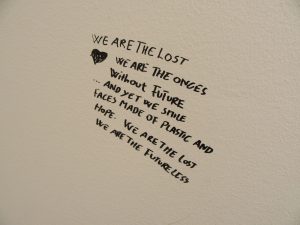
Unknown poet
Another poster told the story of Usha Grace Balamanoharan: a 47 year old woman from Sri Lanka who in her late 30s “came down with stress. [W]hen it was at its worst, I couldn’t manage taking a shower.” Here is what she had to say:
Stress is a widespread national disease caused by the quest for the perfect life. You have to be the perfect mother, the perfect wife, the perfect employee. You have to do the shopping, pay the rent, be in control of your pension.
You end up out of breath, all whilst you are constantly bombarded with all the misery in the world. But I don’t want to watch videos of people being tortured, because there is nothing I can do about it. I feel sad, powerless, unable to stay focused on the immediate world where I can actually make a difference for others. It makes me wish for a single ticket to a desert island. I long to get my childhood back, I lived at an asylum centre and actually was extremely happy. I didn’t see the uncertainty and I had no worries. I identify with Pocahontas. […] She is unaware of the violence in the world. She leaves in peace and accept and is tolerant with outsiders. It evokes a longing in me for something more authentic. A smaller world with more presence. (Ibid)
- All rights reserved to Maja Nydal Eriksen http://www.100pctfremmed.dk
- All rights reserved to Maja Nydal Eriksen http://www.100pctfremmed.dk
In her picture, the woman holds the paws of her grey Husky or Malamute and they both stare straight at the camera with wide, open eyes. How can it be that humans experience such similar suffering across the world, yet we still fight one another, demand that we, “I,” “the ego” is right? Who really is hurting more? Why must we create these absurd theories about how things are to make us feel better about hurting others? Or validating ourselves? People say that it is greed. The need to feel comfortable creates the desire to retain more things out of fear of losing said comfort. I see the validity in this, but humans have evolved brains, it’s what makes us Homo sapiens. Do we not have agency to choose a rational decision over these primitive desires? I do admit, to much chagrin, the torrential force that the desire for comfort has on even the enlightened mind. How many priests have broken their celibacy out of desire? How many people have stolen because they are hungry? The list goes on ad infinitum.
Eventually I tore myself away from the pillars and began pedaling along the water. I headed towards the iconic statue of “Den Lille Haufrue” or “The Little Mermaid,” a symbol of Copenhagen. I passed through Nydhan where old wooden schooners line the canal and cute open-air restaurants make me wonder if Venice looks like something similar. I gave a man playing classical, possibly flamenco, guitar 20 kroner. I honestly think I gave him like 40 kroner, I don’t know, his smile was as serene as Buddha’s and his music rang lovelier and lonelier than any other busker I had heard besides the man with the accordion I heard this morning.
- The path along the waterfront of Island Brygge
- More castle-like structures
- Tall spires
- Brick buildings
- Canal Nydhan
- schooners in Nydhan
- Window art made of life jackets!
- Look at all the life jackets
- Biking around looking at cool buildings
- Close-up of cool dome
- More beautiful buildings
- Gold
I rode through a lush green park where swans and ducks alike glided across the glassy still pond. The statue itself was rather unimpressive compared to the journey to get there. Like most of the touristy attractions I have been to, you have to wait in line to take a photo. The bronze statue of the mermaid was based off the wife of the rich man who paid the artist to sculpt her. I personally preferred the beautiful man with arms covered in tattoos serving ice cream at the stand nearby.
Suddenly, I had a craving for ice cream.
- Church in the middle of the park
- Beautiful sunset
- Epic fountain
- “Thar she blows!”
- Info sign
- Den Lille Havfrue
- The Little Mermaid
- Canal in the background
- Angel statue
- Lovely oxidized copper
- Biking back home through a monument to the Danish international effort
- Info sign
I decided to bike back home for dinner (after all, I did buy those groceries), but I passed through a military establishment of cookie cutter long red buildings and stopped in Nydhan again at Wafflebergen to quench my sweet tooth. The place smelled so wonderful like freshly baked cake! I decided that the order of meals would be reversed tonight. Dessert first. Two scoops of ice cream: walnut and chocolate with marshmellow on top. I thought I ordered the chocolate covered marshmellow thing the people in front of me had ordered when I asked the server for marshmellow, but instead she laid on a thick layer of soft pink, the consistency of whipped cream. It tasted like strawberry jam.
I took my feast to the bank of the canal and draped my legs over the edge. As I watched the tourists in the long, squat boats like motorized crocodiles pass by, I sang “Coin Operated Boy” by The Dresden Dolls over and over again in my head. Even though it was a Sunday, I decided to venture out after eating a salad back at the apartment. I googled “best gay bars in Copenhagen” and the places that struck me the most were a lesbian bar called Vela Bar and a piano bar called Café Intime. My friend Fred back home always told me about the piano bars in New York City that he would frequent in the 90s. He always spoke of them fondly in moments of nostalgia, thus Café Intime it was.
Quietly sneaking out as to not bother my host Amanda, who I am pretty sure could have cared less, I made my way back down to Fredericksburg. Copenhagen at night reminds me of the setting of a gothic novel. Perhaps a Sherlock Holmes mystery, but insert a woman riding her bicycle with earbuds in.
The name “Café Intime” glowed in luminous incandescent bulbs arranged in letters on the front of the café. I could already smell the smoke from outside. Inside jazz music played softly from the stereo, chandeliers hung a soft moody light over the mostly older clientele smoking inside. A grand piano sat relaxing in a corner. Vintage drawings of characers on Christiania bikes framed the velvety red walls. I sat down at the bar and ordered a Moscow Mule. When she asked to confirm if it was vodka, ginger ale, and lime I knew I had made the wrong choice. No soon had I sat down then a man pulled up a chair next to me. He introduced himself as Adam and he was an industrial designer who recently closed his studio next door to work on virtual reality apps. He was ordering beers for him and his friend Manusce who eventually came to join us at the bar when he realized his friend was not coming back. Manusce turned out to be a photographer and music aficionado. His eyes lit up when we talked about our common love of Elliott Smith. Now here’s where the serendipity gets intense: he showed me his Instagram with his portraits and I recognized the dreamy-eyed, blonde hair of the frontman for the band Malle took me to see yesterday. When I asked if it was TJ & The Reason To Live, the man smiled wide with delight. How did I know of that band? That’s when I put two and two together. I recognized him because he had been standing next to us at the concert.
The three of us ended up chatting until the bar closed and it was honestly one of the best interactions with other people I’ve had this entire trip. We parted ways at the end of the night and Adam told me to not be a tourist and just follow where instinct took me. I rode back home along Nørrebruten with a smile on my face. The ride back to the apartment was starting to feel familiar.
